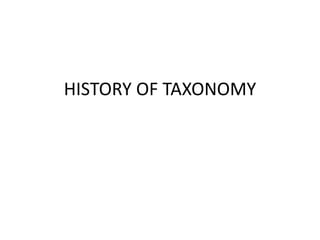
History of taxonomy 3
- 2. • Mayr described the history of taxonomy in four periods. • 1st Period • 2nd Period • 3rd Period • 4th Period
- 3. 1st Period(Study of local fauna) • Native of primitive tribes were excellent naturalist. • Study of fauna came from the contribution of greek scholars. • Aristotle(384-322 b.c) ,known as the father of biological classification,referred to major groups of animals as birds,fishes,whales and insects.
- 4. • Aristotle thinking dominated for next two thousand years. • There are two major form of classification in first period. • i.Downward classification • Ii.Upward classification
- 5. i.Downward classification • Taxonomy based on local fauna reached its peak by the work of Linnaeus(1707-1778). • The method of downward classification are principles of logical division which consists of dividing larger groups by dichotomy into smaller groups.e.g, • Animals
- 7. • Linnaeus adopted the principle of downward classification in 15th edition of his book(Systema naturae) • He for the first time applied Binomial nomenclature to animal kingdom. • Linnaeus believed in fixity of species.
- 8. ii.Upward classification • By the mid of 18th century the shortcommings of downward classification were recognized. • Gradually it was replaced by upward classification. • It consists of assembling species by inspection into a group of similar or related species and forming hierarchy by again grouping of similar taxa of next lower rank.
- 9. • This thought was applied by a botanist in 1873 and later by nearly all zoologists. • This shift from downward classification to upward classification was a major philosophic change.
- 10. Family Genus 1 spp1 spp2 Genus 2 spp1
- 11. 2nd Period(Acceptence of evoluton) • Evolutionary thought was widespread in 18th century but owes its foundation to second period. • Darwin believed in fixity of species.but after observing natural fauna in Galapagos island,he begin to believe in the plasticity of species. • Empirical taxonomists were greatly influenced by his idea.
- 12. • The phylogenetic tree of Ernest Haeckal also stimulated the empirical workers. • Large number of new species were discovered and described.
- 13. 3rd Period(Population systematics) • The greatest development of modern taxonomy srarted around 1930,when the workers realized that the Linnaeus species based on one or two specimens are not as perfect as those which are based on population. • Due to this Mayr in 1942 considered species as a group of interbreeding natural population.
- 14. • This idea of population taxonomy was useful in developing the polytypic concept. • New terms like new systematics and biosystematics were added to extend the taxonomic theory. • The publication of the book ‘new systematics become a landmark in the history of taxonomy. • Thus taxonomy got a new label of biological taxonomy. • By 1955 taxonomy reach such a status that it was called taxonomic explosion.
- 15. 4th Period (current trends) • New systematics deal exclusively with species. • The present day taxonomic work include all available differences and similarities. • Instead of morphology as an original base,phylogenetic adaptations,embryological patterns,biochemical variations,genetic variabilities and similarities,behavioural characteristics are all applicable to taxonomic study.
